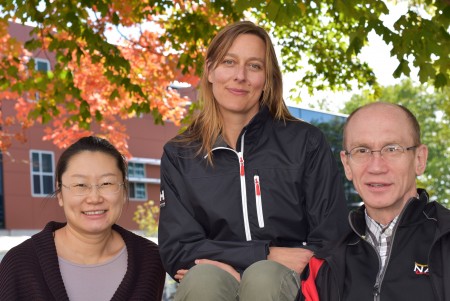
To tackle growing waste problems, Kathryn Preuss is thinking small — really small. The U of G chemistry professor studies materials at the molecular and even nano scale to turn industrial waste into high-tech molecular materials.
Now she hopes new funding will help a fledgling Guelph science and engineering research group turn some of those ideas into processes and products.
This year, Preuss, along with engineering professor Emily Chiang, received support from the Ontario Research Fund and the Canada Foundation for Innovation to help create the Advanced Materials Research Consortium.
The group will bring together researchers from the College of Physical and Engineering Science and the Ontario Agricultural College to study a range of materials.
Preuss holds a Canada Research Chair in the Chemistry of Molecular Materials, renewed in 2014 for a second five-year term. With most of the Earth’s naturally occurring elements and substances — and their properties — already catalogued, she says, “we need to design new materials if we want new, advanced technology.”
In particular, she designs molecules with spintronic (spin-based electronic) properties, notably conductivity and magnetism. Those properties hold promise for improving computing, especially better data storage and faster, more efficient quantum computing.
Together, the group members study physical structure and properties of materials.
Chiang is interested in creating value-added materials from waste, or waste valorization. That includes using metallurgical slags to sequester carbon, using incineration ash to mop up heavy metals and making antioxidants from micro-algae in bio-ethanol wastes.
Prof. Dmitriy Soldatov, Department of Chemistry, has looked at building molecules to improve drug delivery, develop fuels and build sensors for detecting pollutants, and chemistry professor Marcel Schlaf has studied potential use of red mud — a by-product of aluminum processing — to turn farm and forestry biomass into oil.
Says Chiang, “We want to expand materials research through multidisciplinary collaboration and connect industrial needs with advances in research.”
She expects the group will help give graduate students a wider view of materials research.
Preuss looks at the physical properties of materials and relates them to chemical structure. Change the temperature of a material, and you might alter its conductivity or magnetism. Other changes might make molecules glow, improving the display on your computer screen.
Earlier this year, she received a Women of Distinction award in the science and research category from the YMCA-YWCA Guelph.
“I like understanding things. To be able to push technology forward, you can’t just randomly aim and hope it works. You have to have a design,” she says. “I find it kind of beautiful, the molecular structure — so much symmetry.”